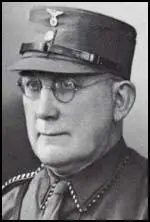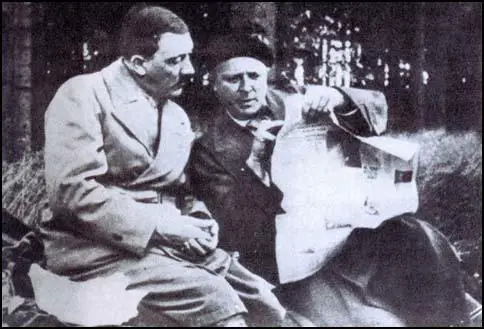Kurt Lüdecke

Kurt Lüdecke was born in Berlin on 5th February 1890. He came from a wealthy background and was well-educated and spoke several foreign languages and travelled widely in his youth. Lüdecke had a private income and did not have to earn a living.
Lüdecke saw Adolf Hitler speak on 11th August 1922. He later recalled: "I studied this slight, pale man, his brown hair parted on one side and falling again and again over his sweating brow. Threatening and beseeching, with small pleading hands and flaming steel-blue eyes, he had the look of a fanatic. Presently my critical faculty was swept away he was holding the masses, and me with them, under a hypnotic spell by the sheer force of his conviction."
The following day, Lüdecke joined the National Socialist German Workers Party (NSDAP). Lüdecke considered the Sturmabteilung (SA) as "little better than gangs". He approached Hitler and suggested that he should form an elite, well-disciplined company of Storm Troopers. He thought that their example might prove an inspiration to the rest of the SA. Hitler agreed and as James Pool points out: "Lüdecke began recruiting, accepting only the toughest and most able-bodied men who had either served in the war or had some military training. Two former Army officers were appointed as platoon leaders. A number of young students began to join the troop. A band with four drummers and four fifers was organized. Drills were held regularly. Every Wednesday night the entire company would assemble in a room Lüdecke had rented in a cafe on Schoenfeldstrasse, where he lectured his men on the political aims of the Nazi Party. Every new member took an oath of allegiance on the swastika flag and pledged loyalty to Hitler."
Lüdecke also bought the uniforms and other equipment for the men. Except for a few small details, the appearance of Lüdecke's men was almost indistinguishable from regular Army troops. Their uniform consisted of Army tunic, military breeches, Austrian ski-caps, leggings, and combat boots. each man also wore a leather belt and a swastika armband. By the end of December 1922 about 100 men. Lüdecke a close friend of Ernst Roehm had managed to help him obtain 15 heavy Maxim guns, more than 200 hand grenades, 175 rifles and thousands of rounds of ammunition. According to Lüdecke's own account, he earned the money to finance his S.A. troop by selling treadless tires to the Russian government.
Adolf Hitler asked Lüdecke if he would use his contacts to raise funds for the Nazi Party. "It was just the sort of confidential work I wanted." However, it was a difficult task and "brought many headaches and few results". Lüdecke later reported that it was easier to win over a "100 common men than to convert a single gentleman". According to Lüdecke "the more educated the man, the greater his academic resistance to the impossible and undignified program advocated by that uncultivated radical. Lüdecke also discovered that the wealthy feared the socialist side of the Nazi program.
One of the principal sources of money and equipment for the Sturmabteilung (SA) was the secret German Army originally set up to finance Free Corps units and military intelligence work. James Pool, the author of Who Financed Hitler: The Secret Funding of Hitler's Rise to Power (1979) has pointed out: Up to now historians have incorrectly assumed that assistance was given to Hitler on the orders of the High Command of the Bavarian Army. Actually most of the aid was given to Hitler on the initiative of one officer, Captain Ernst Roehm, without the knowledge or approval of his superiors." Lüdecke said that Ernst Roehm "was of decisive importance to the Nazi Party, finding money, arms, and men at the most critical times."
In September 1922 Lüdecke was sent by Adolf Hitler to meet Benito Mussolini. It was Lüdecke's assignment "to size up the Italian Fascists, estimate their chances for success, get Mussolini's opinions on certain issues, and find out how the Nazis and Blackshirts might cooperate." Since Mussolini spoke only a few words of German, and Lüdecke only a smattering of Italian, they conducted the discussion in French. Lüdecke later recalled that he had to explain the German political situation from the beginning, as Mussolini had never heard of Hitler. Lüdecke pointed out the numerous similarities between Nazism and Fascism: both were extremely nationalist and anti-Communist; both had leaders who were men of the people, veterans, self-made, and outstanding political speakers.
Mussolini introduced Lüdecke to sympathetic journalists. This led to several pro-Nazi articles appearing in Italian newspapers. Leo Negrelli interviewed Hitler, who used the opportunity to attack the German government. The socialist newspaper, Avanti, strongly criticised the Italian government for permitting such "propaganda" to be printed against the German government. On 25th October, 1923, the pro-Fascist journal L'Epoca, included an interview with Lüdecke on its front page, under the headline "The Government of Berlin is Accused of Treason by Hitler's Representative."
In 1924 Lüdecke sent Winifred Wagner to the United States to obtain funds for the Nazi Party. This including meeting Henry Ford. She admitted to James Pool in 1977: "Ford told me that he had helped to finance Hitler with money from the sales of automobiles and trucks that he had sent to Germany." Winifred suggested that Hitler was now more in need for money than ever. Ford replied that he was still willing to support if he was still working to free Germany from the Jews. Wagner arranged for Ludecke to pay Ford a visit.
At the arranged meeting, Lüdecke promised that as soon as Hitler came to power, one of his first acts would be to inaugurate the social and political program which had been advocated in the Dearborn Independent. Ludecke explained that money was the only obstacle that stood between the Nazis and the fulfillment in Germany of Ford and Hitler's mutual views. In his memoirs published in 1938 Lüdecke did not say how much Ford gave to Hitler. Lüdecke hinted at why he could not tell the truth without hurting Ford. The Jewish boycott had "pinched him in the ledgers where even a multimillionaire is vulnerable." Lüdecke described Ford as having "clear, bright eyes and his strong face, almost free from wrinkles, did not betray his more than sixty years."

Lüdecke remained very close to Ernst Roehm. In January 1934, Roehm told Ludecke: "Hitler can't walk over me as he might have done a year ago; I've seen to that. Don't forget that I have three million men, with every key position in the hands of my own people, Hitler knows that I have friends in the Reichswehr, you know! If Hitler is reasonable I shall settle the matter quietly; if he isn't I must be prepared to use force - not for my sake but for the sake of our revolution."
On 29th June, 1934. Hitler, accompanied by the Schutzstaffel (SS), arrived at Bad Wiesse, where he personally arrested Ernst Roehm. During the next 24 hours 200 other senior SA officers were arrested on the way to the meeting. Erich Kempka, Hitler's chauffeur, witnessed what happened: "Hitler entered Roehm's bedroom alone with a whip in his hand. Behind him were two detectives with pistols at the ready. He spat out the words; Roehm, you are under arrest. Roehm's doctor comes out of a room and to our surprise he has his wife with him. I hear Lutze putting in a good word for him with Hitler. Then Hitler walks up to him, greets him, shakes hand with his wife and asks them to leave the hotel, it isn't a pleasant place for them to stay in, that day. Now the bus arrives. Quickly, the SA leaders are collected from the laundry room and walk past Roehm under police guard. Roehm looks up from his coffee sadly and waves to them in a melancholy way. At last Roehm too is led from the hotel. He walks past Hitler with his head bowed, completely apathetic."
A large number of the SA officers were shot as soon as they were captured but Adolf Hitler decided to pardon Roehm because of his past services to the movement. However, after much pressure from Hermann Goering and Heinrich Himmler, Hitler agreed that Roehm should die. At first Hitler insisted that Roehm should be allowed to commit suicide but, when he refused, Ernst Roehm was killed by two SS men.
Ludecke was also arrested but he was eventually allowed to move to Switzerland. He published I Knew Hitler in 1938. It was the first book to be written by Hitler's inner-circle. Ludecke was careful not to betray those foreign industrialists who gave money to the Nazi Party. However, the book is considered by most historians as a highly reliable original source.
Kurt Lüdecke died in Prien am Chiemsee in 1960.
Primary Sources
(1) James Pool, Who Financed Hitler: The Secret Funding of Hitler's Rise to Power (1979)
Lüdecke began recruiting, accepting only the toughest and most able-bodied men who had either served in the war or had some military training. Two former Army officers were appointed as platoon leaders. A number of young students began to joib the troop. A band with four drummers and four fifers was organized. Drills were held regularly. Every Wednesday night the entire company would assemble in a room Lüdecke had rented in a cafe on Schoenfeldstrasse, where he lectured his men on the political aims of the Nazi Party. Every new member took an oath of allegiance on the swastika flag and pledged loyalty to Hitler.

